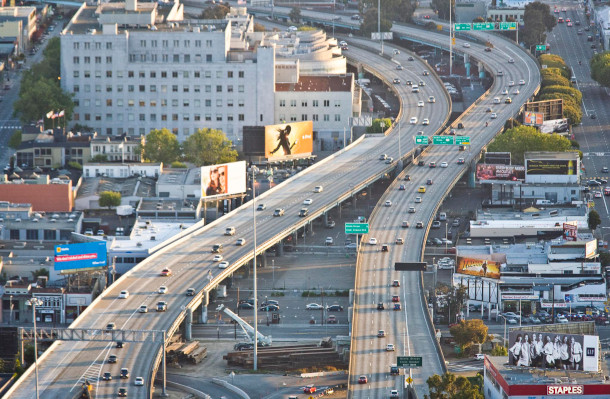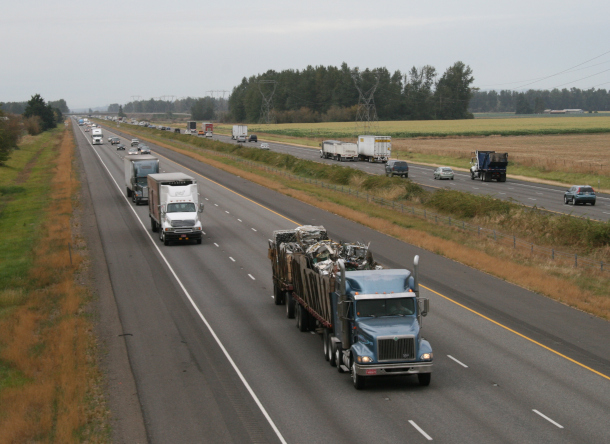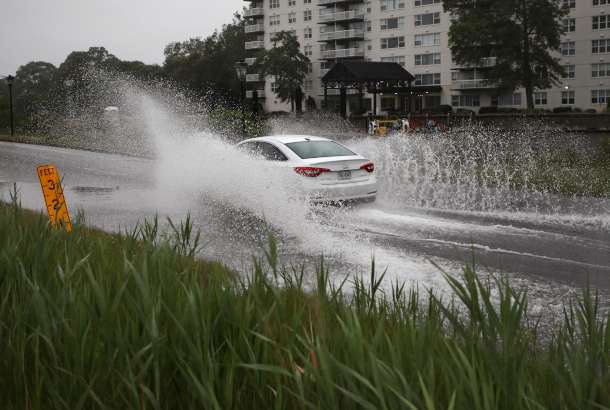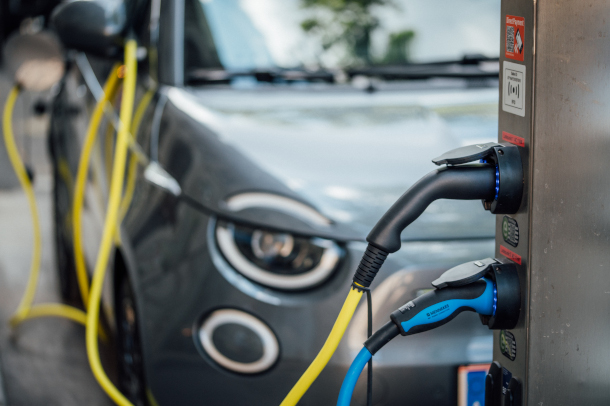The Long and Winding Road to Green Infrastructure
Air Date: Week of August 20, 2021

According to the American Society of Civil Engineers 2021 report card, more than 7% of US bridges are considered structurally unsound. (Photo: Thomas Hawk, Flickr, CC BY-NC 2.0)
The $1.2 trillion bipartisan infrastructure bill includes some green measures to address and invest in crumbling American infrastructure. But climate and environmental justice advocates say much more is needed now from a much larger budget reconciliation package that’s in the works. Rachel Cleetus of the Union of Concerned Scientists joins Host Paloma Beltran to discuss where the bipartisan bill falls short on green investments and what’s needed in the budget reconciliation bill.
Transcript
DOERING: It’s Living on Earth, I’m Jenni Doering.
BELTRAN: And I’m Paloma Beltran
The Senate recently passed a 1.2 trillion dollar bipartisan infrastructure bill. That’s a lot of money but roughly half of what experts say is necessary to bring US infrastructure to where it should be. As it is, the American Society of Civil Engineers gave US infrastructure a grade of C-. According to their 2021 report card more than 7% of US bridges are considered structurally unsound. 40 percent of our roads are poor or mediocre, and we waste roughly 6 billion gallons of treated water each day due to breaks and leaks. The infrastructure bill promises to address many such problems - and is now heading to the Democratically controlled House of Representatives. At the same time, Democrats are working on a 3.5 trillion dollar budget reconciliation bill. That bill would go even further with green infrastructure and aligns with the administration’s Justice40 program. That’s the goal of delivering 40 percent of the benefits of federal investments in climate and energy to disadvantaged communities. Rachel Cleetus is the policy director and lead economist in the climate and energy program at the Union of Concerned scientists. She joins me now with details from the infrastructure bill.
CLEETUS: It has some important investments in electric vehicle infrastructure. It has some important investments in public transit, and rail, in broadband in investments in climate science for NOAA, in climate resilience, and it has some important investments in making sure that we're cleaning up communities that have been subjected to a disproportionate burden of pollution. So there are some really important investments across the board in this bill. That said, they're nowhere near the scale that we need to address climate change in a just bold and equitable way. And that's why we're going to be pushing for more in another bill, the door to which was also opened earlier this month when the Senate passed budget resolution.
BELTRAN: So transportation is now the biggest single source of greenhouse gases in the United States and a key focus of the infrastructure package. How does the bill address are carbon-intensive transportation system?

Infrastructure in the United States has been deteriorating for decades. The bipartisan infrastructure bill will invest in traditional infrastructure like highways and bridges, but those who are concerned about climate change hope it is the first step in a transition to renewable energy and climate resilient infrastructure. (Photo: born1985, Flickr, CC BY 2.0)
CLEETUS: So the bill includes about $7.5 billion to build out a national network of electric vehicle charging stations. This is obviously a very important foundational piece to get our transportation sector to move towards a more electrified transportation sector and one where the electricity is coming from clean sources. There is some investments, about $5 billion worth of investments, in zero emission, clean buses, and 2.5 billion for ferries. But there's nowhere near enough, we need much, much more to actually move our transportation sector to a more electrified infrastructure, we need much more in the EV infrastructure, as well as in public transit. There is some public transit money, which is actually ironically, we have so far under invested in public transit in our nation, that this $39 billion worth of new investment in public transit is actually the single biggest investment that's been made. And it's still falling far short of what's needed. There is, of course, a lot of traditional investment in roads and bridges and highways. But these investments need to be more climate resilient, going forward, because we're seeing worsening climate impacts wash out roads and bridges. And that is not just a cost in infrastructure, but it can lead to business interruptions, and it has a huge economic and financial burden. So as we move forward, we have to be thinking in this holistic frame, both low carbon and climate resilient.
BELTRAN: You know, Rachel, when it comes to climate impacts and extreme weather, it's safe to say that a lot of federal response in the past has been focused on directing funds towards recovery, and adaptation instead of mitigation. In other words, lowering greenhouse gas emissions to begin with. How might these packages change that, if at all?

As climate impacts like sea level rise become more and more tangible, traditional infrastructure is becoming compromised. For instance, coastal roads like this one in Norfolk, Virginia face the recurring threat of nuisance flooding due to sea level rise. New infrastructure must integrate climate resilience features in order to last. (Photo: Aileen Devlin, Virginia Sea Grant, Flickr, CC BY-ND 2.0)
CLEETUS: The bipartisan infrastructure bill that just passed, the Senate included some important investments in programs run by FEMA, the Federal Emergency Management Agency, the lead agency that's responsible for our nation's response to a variety of disasters, including climate-related ones. But what we have to do now is move towards a mindset where we're acting beforehand, proactively guided by the science guided by the needs of communities, and in an equitable and just way, not just picking up the pieces after a disaster hits. And what the bipartisan infrastructure deal included was an investment in a program called BRIC that the Federal Emergency Management Agency runs, which is about investing ahead of time in communities. Now, it's nowhere near enough money, we're going to need more than that. And we hope to see that in the next bill that's prepared. But this is the way in which we have to start working as a nation. There's also a very important opportunity if in this next bill, if we can secure the Civilian Climate Corps, which is another way in which we can help make sure that communities have the resources they need to be better protected ahead of time. And then finally, all of the infrastructure we're investing in, all of these roads, bridges, electric vehicle, charging infrastructure, the power grid, all of them have to be made resilient in the face of these climate impacts. We have to be thinking about this infrastructure as long lived infrastructure that's going to be around for decades and make sure that we're using science based projections of worsening climate impacts to guide how and where we build these investments.
BELTRAN: Tribal communities have long felt the burden of climate change and pollution here in the United States. How does this bill address their needs? Or how does this bill help them in terms of climate remediation?
CLEETUS: This bill does have some investments that can help tribal communities, the two areas of investment are in electric buses to move away from polluting diesel buses, there was also investments in clean drinking water. The legislation includes a $55 billion investment in clean drinking water nationwide. And some of that is going to be targeted to a tribal nations, which are among the most disadvantaged communities in our country, and have suffered from pollution from lead pipes and other contaminants to drinking water. The investments as well in climate resilience that will flow through the Federal Emergency Management Agency, some of that will also be directed to building resilience in tribal communities that have suffered from drought from wildfires from flooding, and other climate impacts. But again, as we know, in our nation, our history of systemic racism and discrimination has resulted in tribal communities bearing a disproportionate brunt, not just of pollution, but also economic inequities. So much more is needed, and in this next bill, what we hope to see is a more holistic approach that will include investments in social justice programs, public health programs, and education and other programs that are vital for tribal communities and indigenous communities.

The infrastructure bill allocates about $75 billion of the roughly $1 trillion total to broadband, cybersecurity and electric vehicle charging station funding. (Photo: Ivan Radic, Flickr, CC BY 2.0)
BELTRAN: Now, just hours after passing the infrastructure package, Senate Democrats got the ball rolling on a $3.5 trillion budget resolution. From what we know so far, how would this much larger package address the climate crisis?
CLEETUS: The much larger budget resolution that has just been introduced, is taking some really important steps to address a range of issues, a few key pillars, it is going to make sure that we actually deliver on power sector targets that are ambitious. Now, we still need to see the details. This is not secured yet. But the intention here is to ensure that we can get to a power sector that's at least 80% clean by 2030. And on a path to getting 100% clean soon thereafter, that we're actually investing in electric vehicles and electric vehicle infrastructure, that we're investing in a modernized power grid that will help enable integration of higher levels of renewables. There's a very important component around clean energy tax credits, making sure that they're fully funded. These tax credits have been critical and accelerating the deployment of wind, solar and other forms of renewable energy around the country. And we want to make sure that that momentum continues going forward. They're also really important investments in climate resilience that can happen through this larger bill, including a Civilian Climate Corps, that has a model of ensuring that communities around the country are getting the resources and then technical assistance they need to prepare and be protected from climate impacts. So these are just some of the important priorities that this larger bill can help deliver on. And in all cases, it's really important that we think about this not just as a investment in technology and infrastructure, but really an investment in our communities.

As the Policy Director of the Union of Concerned Scientists’ Climate and Energy Program, Rachel Cleetus helps to design equitable climate policy and advocate for its implementation. (Photo: Union of Concerned Scientists)
BELTRAN: This bill sets up a transition from fossil fuel energy to renewable energy. How does this bill address the communities of workers who have worked in the fossil fuel energy sector for years and years?
CLEETUS: The intention is for this plan to include is a very clear set of investments in coal dependent communities and coal workers who are being disproportionately affected as we transition away from coal. These communities, these workers deserve to be treated fairly. They have helped keep the lights on in our country for generations. And now, we need to make sure that they are not left behind as we make this transition. That means ensuring that there is investments and diversifying these local economies in treating workers fairly in terms of providing benefits, providing lost wage replacement for a period of time, providing job training, and educational benefits so that they can also avail of new economic opportunities going forward.
BELTRAN: Rachel Cletus is the policy director with the Climate and Energy Program at the Union of Concerned Scientists. Thank you so much for taking the time with us today, Rachel.
CLEETUS: Thank you so much for having me.
Links
Learn more about Rachel Cleetus and the Union of Concerned Scientists
NYTimes | What’s in the $1 trillion infrastructure package?
NYTimes | Senate Passes $1 Trillion Infrastructure Bill, Handing Biden a Bipartisan Win
Washington Post | Biden aims for sweeping climate action as infrastructure, budget bills advance
Living on Earth wants to hear from you!
Living on Earth
62 Calef Highway, Suite 212
Lee, NH 03861
Telephone: 617-287-4121
E-mail: comments@loe.org
Newsletter [Click here]
Donate to Living on Earth!
Living on Earth is an independent media program and relies entirely on contributions from listeners and institutions supporting public service. Please donate now to preserve an independent environmental voice.
NewsletterLiving on Earth offers a weekly delivery of the show's rundown to your mailbox. Sign up for our newsletter today!
 Sailors For The Sea: Be the change you want to sea.
Sailors For The Sea: Be the change you want to sea.
 The Grantham Foundation for the Protection of the Environment: Committed to protecting and improving the health of the global environment.
The Grantham Foundation for the Protection of the Environment: Committed to protecting and improving the health of the global environment.
 Contribute to Living on Earth and receive, as our gift to you, an archival print of one of Mark Seth Lender's extraordinary wildlife photographs. Follow the link to see Mark's current collection of photographs.
Contribute to Living on Earth and receive, as our gift to you, an archival print of one of Mark Seth Lender's extraordinary wildlife photographs. Follow the link to see Mark's current collection of photographs.
 Buy a signed copy of Mark Seth Lender's book Smeagull the Seagull & support Living on Earth
Buy a signed copy of Mark Seth Lender's book Smeagull the Seagull & support Living on Earth

